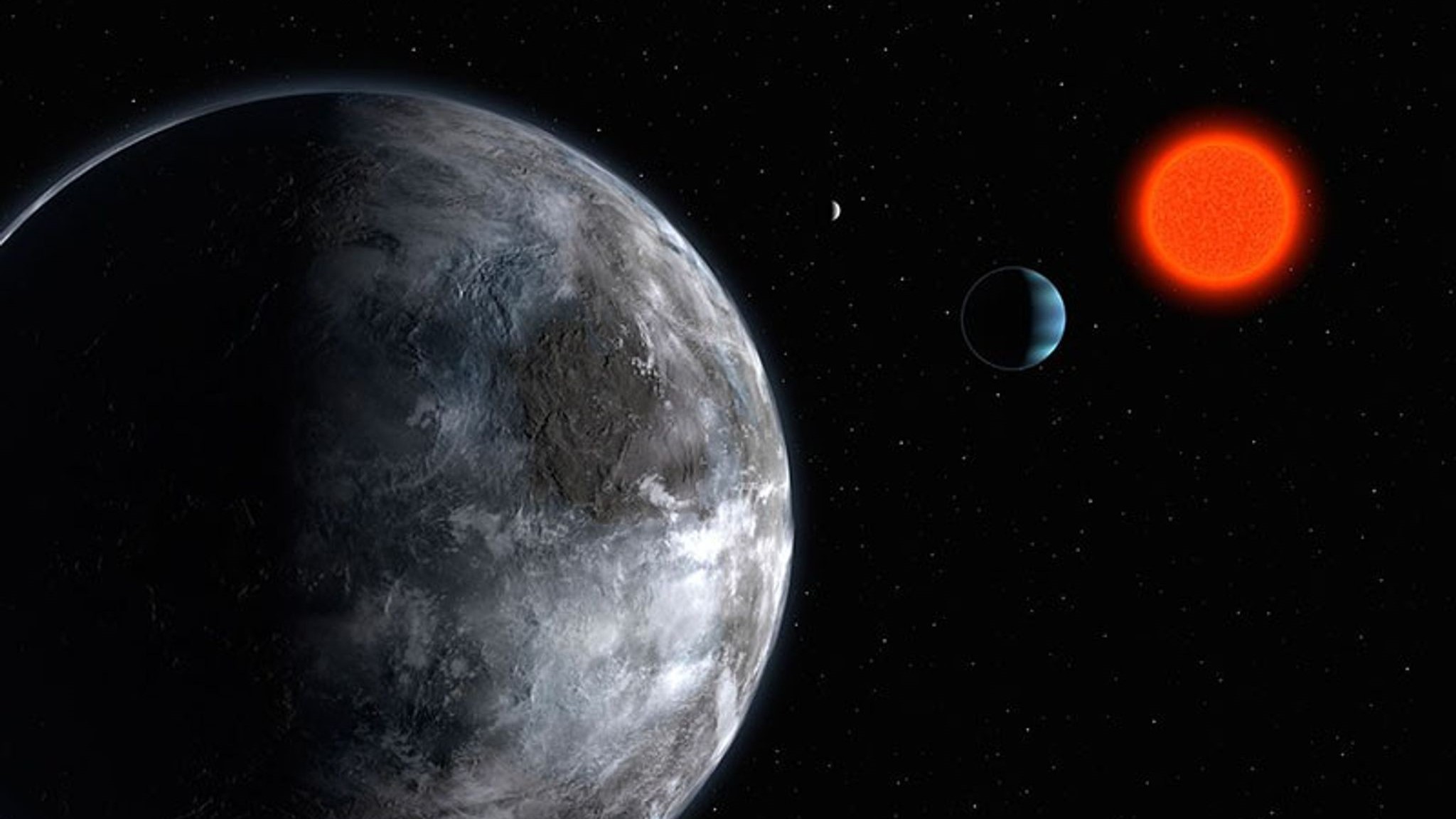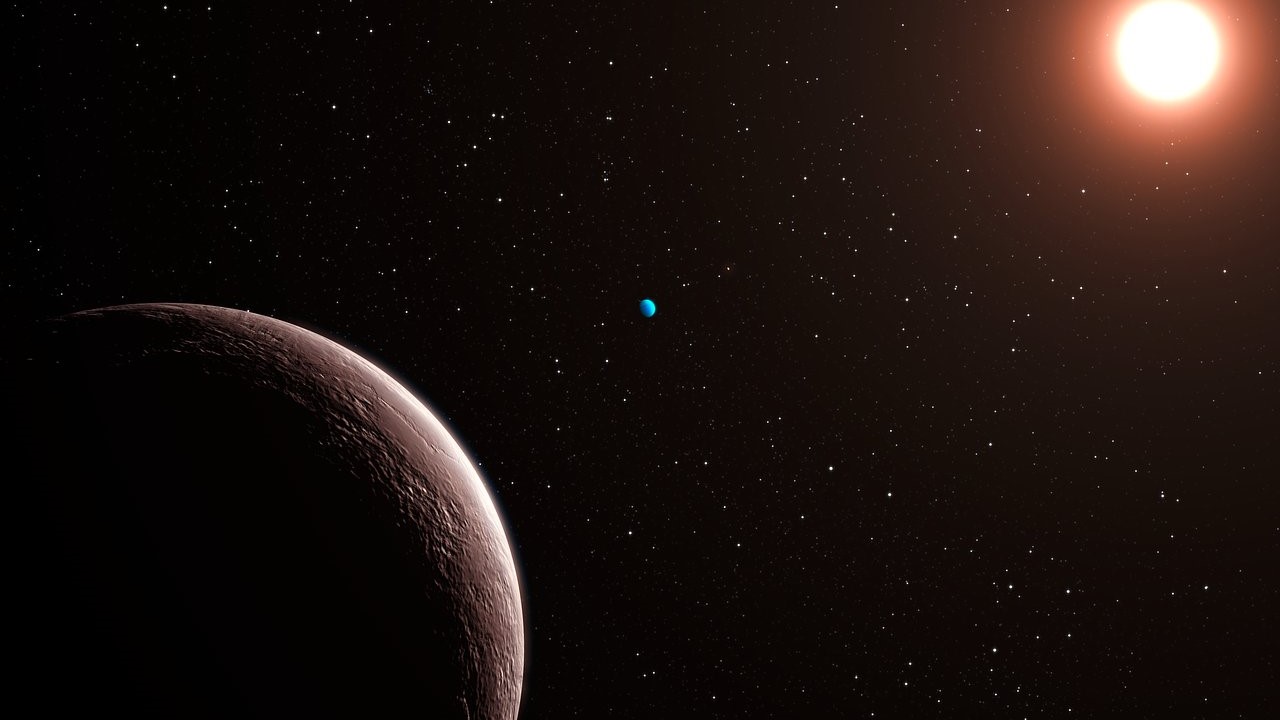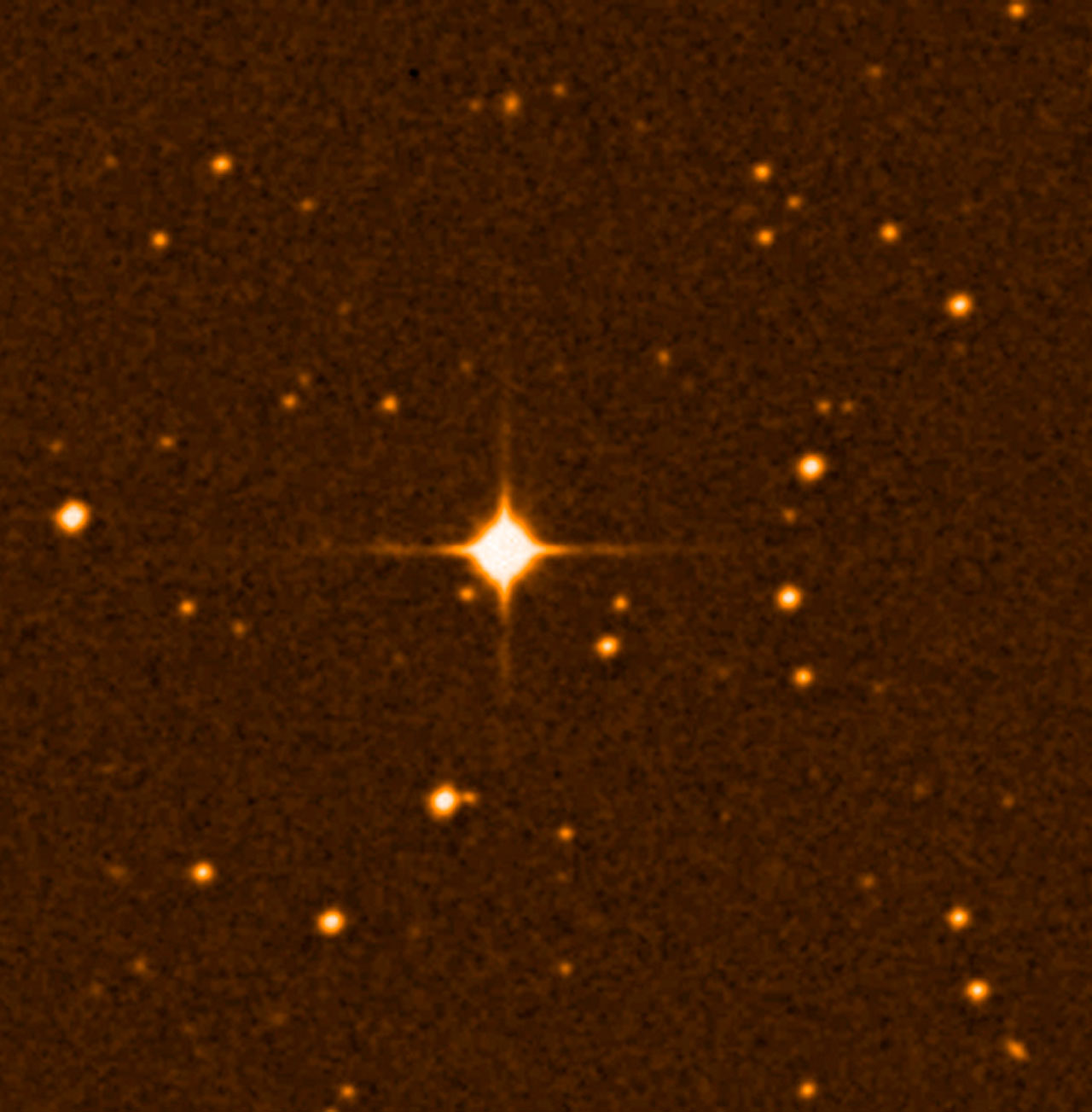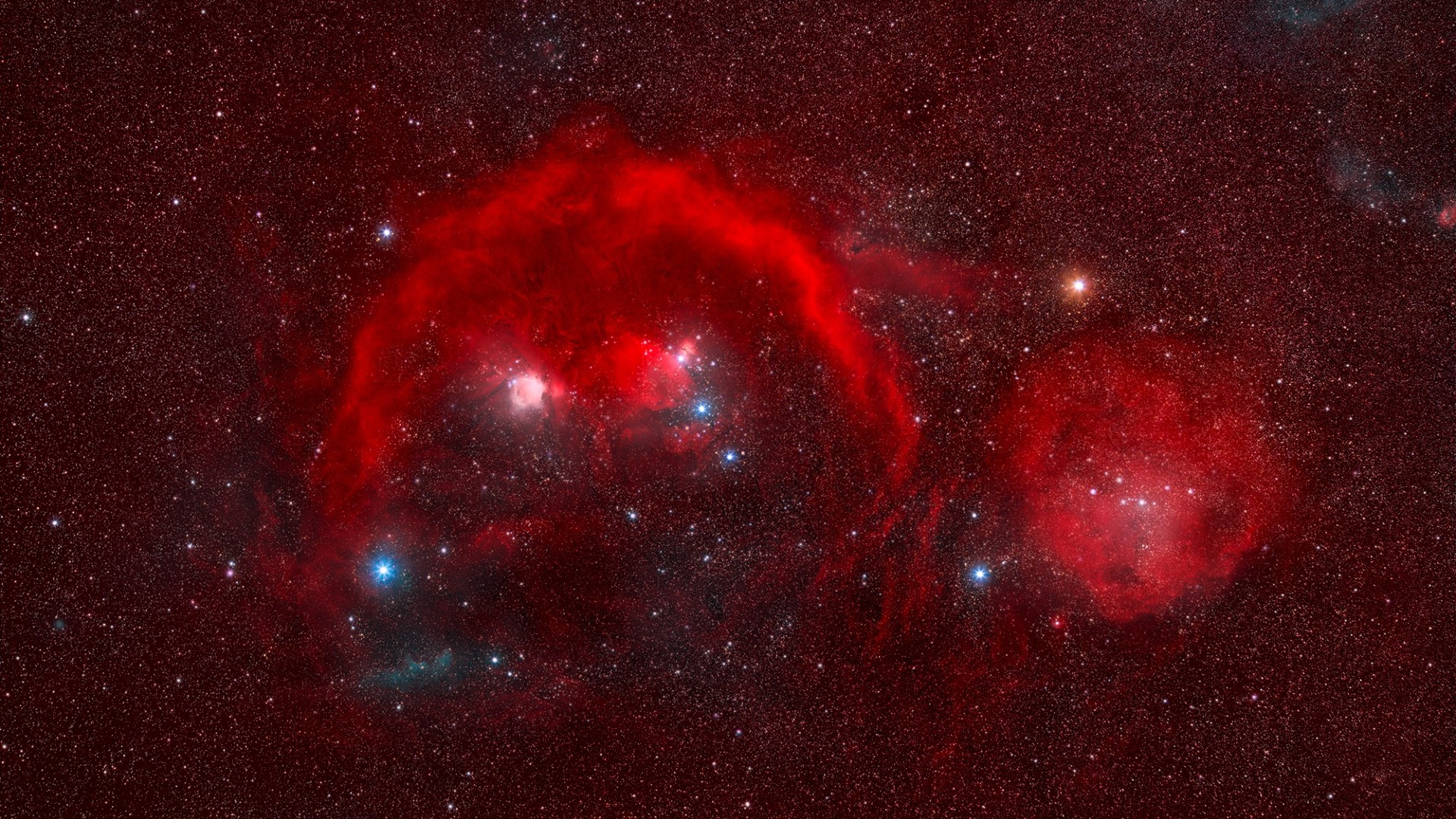Whatever happened to the 'potentially habitable' planet Gliese 581g (and d and f)?
From being the most Earth-like planet known to being consigned to the trash bin, the story of Gliese 581g is a precautionary tale for exoplanet hunters.

In 2010, astronomers discovered what they thought was the most Earth-like planetary candidate known at the time orbiting a red dwarf star. Today, astronomers no longer think the planet, which they'd dubbed Gliese 581g, nor several of its neighbors, are real.
This is the story of what happened to Gliese 581g — a precautionary tale that reminds us not to take all exoplanet discoveries at face value because, as we shall see, the stars themselves can lie.
Gliese 581 is a red dwarf star about 20 light-years from Earth. Starting in 2005, astronomers at the European Southern Observatory (ESO), using the High Accuracy Radial velocity Planet Searcher (HARPS) spectrograph on the 3.6-meter telescope at ESO's La Silla Observatory in Chile, began detecting exoplanets orbiting Gliese 581.
Radial velocity describes how a planet can be detected via its gravitational tug on its parent star. Both the star and its planet(s) orbit the shared center of mass between them. Because the star contains the bulk of the system's mass, the center of mass is found within the star — but importantly, not at the star's very center. Consequently, the star appears to wobble around this center of mass. This wobbling manifests as a subtle redshifting and blueshifting of the star's light, as described by the Doppler effect, as it moves toward and then away from us while wobbling around the center of mass.
The extent of this Doppler shifting tells us the mass of the planet, and the period of the wobble reveals the planet's orbital period. When there are multiple planets in a system, as there are around Gliese 581, there are a lot of radial velocity signals to disentangle. As we'll see, there are also other effects intrinsic to the star itself that can confuse matters.
All of Gliese 581's planets have been found through radial velocity measurements. Unfortunately, the Gliese 581 system is not aligned in such a way that we can see the transits of its planets moving across the face of the star and blocking some of its light.
Gliese FAQs
What is Gliese 581?
Gliese 581 is a red dwarf star about 20 light-years away, in the constellation Libra. It is far too faint to be seen with the naked eye. That's because, even though the star is close, red dwarfs are small and cool, so they are not as bright.
How many planets are around Gliese 581?
There are three known planets, all of which are more massive than Earth, around Gliese 581. There were three other candidates, but they were eventually ruled out (although there's still some debate). Gliese 581 also has a very richly populated belt of comets.
When were Gliese 581g and the other planets discovered?
The first planet candidate around Gliese 581 was found in 2005. Between then and 2010, the other planet candidates, including Gliese 581f and Gliese 581g, were detected, although they are no longer thought to exist.
Are any of Gliese 581's planets habitable?
Two of the claimed planets, Gliese 581d and 581g, were in the habitable zone, which is the distance from the star at which temperatures should be just right for liquid water, assuming the planets have an atmosphere. However, both planets are now thought not to exist.
Could we travel to Gliese 581?
No, we couldn't travel to Gliese 581. Even if we were to travel at the speed of light — which, of course, is not possible — it would take 20 years to get there. Our fastest spacecraft is the Parker Solar Probe, which got a boost to 394,736 mph (635,266 km/h) after a gravitational assist from Venus. Traveling at this velocity, it would take 34,850 years to reach Gliese 581.
Gliese 581's planets

The first exoplanet to be found orbiting Gliese 581 was Gliese 581b. It is a Neptune-size world with a mass at least 15.8 times the mass of Earth, and it orbits its star at a distance of 3.7 million miles (5.97 million kilometers) every 5.4 days. The habitable zone has been shown to begin at a distance of 10.9 million miles (17.5 million km) from the star, so Gliese 581b is too close to the red dwarf — and, therefore, too hot — to be considered habitable.
Next up were two "super-Earths," Gliese 581c and 581d, both announced in April 2007. Gliese 581c is also too hot to be in the habitable zone, orbiting the star at a distance of 6.7 million miles (10.7 million km). However, Gliese 581d was more interesting. Orbiting 20.3 million miles (32.7 million km) from the star every 66.5 days, it was snugly inside the habitable zone. Even though its mass was at least 5.6 times that of Earth, it was still deemed the most Earth-like planet discovered until that point.
A fourth planet, Gliese 581e, was spotted in 2009. This planet was the closest planet to the star, orbiting at a distance of just 2.6 million miles (4.2 million km) every 3.2 days, and its mass is about 2.5 times that of Earth.
Not one of these planets has a direct analog in the solar system. We don't have a Neptune-size planet close to the sun or rocky planets several times Earth's mass. So the worlds of Gliese 581 are very alien to us.
Discovery of Gliese 581f and Gliese 581g
In 2010, a different team announced the discovery of two more planets in the Gliese 581 system. Named Gliese 581f and Gliese 581g, they were found by a team led by Steven Vogt of the Lick Observatory in California and Paul Butler of Carnegie Science in Washington, D.C. One of the claimed planets, Gliese 581g, was very promising. Its discovery was based on 11 years of radial-velocity data collected by the HIRES instrument at the W. M. Keck Observatory atop Mauna Kea in Hawaii, coupled with 4.3 years' worth of data from 119 separate observations made with HARPS.
Moreover, Gliese 581g seemed to sit squarely inside its star's habitable zone. Without an atmosphere, its temperature would be between minus 35 and 12 degrees Fahrenheit (minus 37 to minus 11 degrees Celsius). But an atmosphere could allow the planet to retain heat, like Earth's atmosphere does, so that, in principle, it could be warm enough for liquid water on the surface.
Gliese 581g was, therefore, the most Earth-like exoplanet known at the time, in terms of its mass (at least 3.1 times Earth's mass) and the amount of heat it received from its star, as it orbited at a distance of 13.5 million miles (21.8 million km) every 36.6 days. Coupled with 581d, it meant that Gliese 581 had two planets in its habitable zone.
What happened to Gliese 581g?
Almost immediately, cracks began appearing in the arguments for Gliese 581f and g. The first to question their existence was a study by the same team of European astronomers who found the first four planets around Gliese 581.
Detecting planets via the radial velocity method isn't as simple as finding an alternating redshift and blueshift in a star's light. Stars are roiling, turbulent beasts, and there are intrinsic stellar characteristics that can mimic redshift and blueshift, creating the illusion of an orbiting planet.

For example, the sun has parts of its photosphere and chromosphere, such as plages, that are hotter and brighter — and, therefore, "bluer" — and regions that are cooler and fainter, and correspondingly "redder," such as sunspots. Red dwarf stars such as Gliese 581 have the strongest magnetic fields of all sunlike stars and can produce much larger starspots much more frequently than the sun does, for example.
Because all stars have this kind of activity to some extent, it is always present in the radial velocity measurements. To be certain that a planet — and not just a large starspot — has been detected, the signal must be statistically significant. Instead, the European astronomers argued that, having combined 121 new radial velocity observations from HARPS with the 119 HARPS measurements used in Vogt and Butler's original study, they found no statistical evidence for either planet. A second paper published around the same time used Bayesian statistics to come to the same conclusion: that there are only four planets, and that Gliese 581f and Gliese 581g do not exist.
Vogt and Butler rejected the European findings. They claimed that the team had ignored data that didn't agree with the four-planet model and that their four-planet model was dynamically unstable and, therefore, impossible. Instead, Vogt and Butler reanalyzed the HARPS data and believed they found strong evidence for Gliese 581g, albeit with slightly different properties, including a minimum mass of 2.2 times that of Earth rather than the previously reported 3.1 Earth masses, and an orbital period of 32, not 36, days. Nevertheless, this supposed planet would still be in its star's habitable zone, and its smaller size would make it even more Earth-like.
Doubts about Gliese 581d
That was as good as it got for claims for planets Gliese 581f and Gliese 581g. In 2014, a study led by Paul Robertson of Pennsylvania State University concluded that stellar activity was masquerading as the planets in Gliese 581's habitable zone. They measured the star's rotation period as 130 days plus or minus two days (this was later refined to 132 days) and that starspots moving in and out of view as the star rotated were mimicking not only planets f and g but also planet d, which suspiciously had a claimed orbital period half that of the star's measured rotation. So now there were three planets in the firing line!
Back and forth the debate went. With the potential loss of planet d as well, the stakes were higher. "The existence (or not) of GJ [Gliese] 581d is significant because it was the first Earth-like planet discovered in the 'Goldilocks'-zone around another star and it is a benchmark case for the Doppler technique," Guillem Anglada-Escudé, an astronomer at Queen Mary University of London, said in a statement in 2015.
The debate surrounding planet d swiftly ended in 2016, when Artie Hatzes, an astronomer at the Karl Schwarzschild Observatory in Germany, showed that hydrogen-alpha emissions on the star with a frequency of 66.7 days were 180 degrees out of phase with the supposed orbit of planet d. In other words, the frequency of these hydrogen-alpha emissions resulting from stellar activity were creating the illusion that there was a planet orbiting roughly every 66.5 days.
A year later, the stories of planets f and g were also brought to an end. A survey conducted by the CARMENES (Calar Alto high-Resolution search for M dwarfs with Exoearths with Near-infrared and optical Échelle Spectrographs) radial velocity measuring instrument at the Calar Alto Observatory in Spain confirmed that there were only three planets orbiting Gliese 581: b, c and e.
Not the end of the story
The lesson from all of this is to remember that when astronomers talk about having discovered an exoplanet, it does not usually mean they have seen it with their own eyes through a telescope. The existence of exoplanets is usually inferred indirectly, and the signals are often so faint that we need multiple observations to be statistically sure the planet is there.
That's why you might often see the phrase "planet candidate," which is a signal, either from radial velocity or transit, that we think is a planet but have not yet achieved statistical significance in the observations or, alternatively, have not been seen in both transits and radial velocity, the two independent methods providing a degree of verification for each other. And even when we think we're sure, the case of Gliese 581 reminds us just how difficult these exoplanet observations can be.
In fact, the story of Gliese 581's planets is not over. In January 2024, astronomers Manfred Cuntz of the University of Texas at Arlington and Scott Engle and Edward Guinan of Villanova University in Pennsylvania reported that they suspected the spectroscopic measurements of Gliese 581's rotation — and, therefore, its stellar activity — were inaccurate.
They calculated that the star spins on its axis once every 148.7 days — more than 16 days longer than the previously presupposed period. Remember, planet d was originally ruled out because its orbital period was half that of the star's originally calculated rotation period, connecting its signal with activity on the star. However, this is not the case if the new value for the stellar rotation is correct. Cuntz, Engle and Guinan are not claiming planet d exists; they are just saying the main reason for ruling out the planet has been shown to be inaccurate.
So this isn't the end of Gliese 581d's story. Stay tuned to find out what happens next!
Additional resources
Keep tabs on new exoplanet candidates and planet confirmations via NASA's Exoplanet Catalog and Europe's Encyclopaedia of Exoplanetary Systems.
Check out news from the latest exoplanet-hunting spacecraft, NASA's Transiting Exoplanet Survey Satellite mission.
See plans for the European Space Agency's exoplanet-hunting mission, PLATO (Planetary Transits and Oscillations of Stars).
Bibliography
NASA; 'Gliese 581', https://science.nasa.gov/resource/gliese-581/
ESO; 'HARPS: The Planet Hunter', https://www.eso.org/sci/facilities/lasilla/instruments/harps/overview.html
ESO; '3.6-Meter Telescope', https://www.eso.org/public/teles-instr/lasilla/36/
ESO; 'La Silla Observatory: ESO's First Observatory', https://www.eso.org/public/teles-instr/lasilla/
Xavier Bonfils et al; 'The HARPS Search for Southern Extra-solar Planets Part VI: A neptune-mass Planet Around the Nearby M Dwarf Gl 581', Astronomy & Astrophysics, Vol 443 (2005) https://www.aanda.org/articles/aa/abs/2005/45/aahh223/aahh223.html
How We Find and Classify Exoplanets, NASA, https://science.nasa.gov/exoplanets/how-we-find-and-characterize/
What's A Transit?, NASA, https://science.nasa.gov/exoplanets/whats-a-transit/
NASA Exoplanets: Gliese 581b, https://science.nasa.gov/exoplanet-catalog/gj-581-b/
P. von Paris et al; 'Atmospheric Studies of Habitability in the Gliese 581 System', Astronomy & Astrophysics, Vol 532 (2011) https://www.aanda.org/articles/aa/full_html/2011/08/aa16058-10/aa16058-10.html
Stephane Udry et al; 'The HARPS Search for Southern Extra-Solar Planets Part XI: Super-Earths (5 and 8Me) in a 3-Planet System', Astronomy & Astrophysics, Vol 469 (2007) https://www.aanda.org/articles/aa/abs/2007/27/aa7612-07/aa7612-07.html
Michel Mayor et al; 'The HARPS Search for Southern Extra-Solar Planets Part XVIII: An Earth-Mass Planet in the GJ 581 Planetary System', Astronomy & Astrophysics, Vol 507 (2009) https://www.aanda.org/articles/aa/full_html/2009/43/aa12172-09/aa12172-09.html
Steven S. Vogt et al; 'The Lick–Carnegie Exoplanet Survey: A 3.1Me Planet in the Habitable Zone of the Nearby M3V Star Gliese 581', The Astrophysical Journal, Vol 723, No. 1 (2010) https://iopscience.iop.org/article/10.1088/0004-637X/723/1/954
HIRES Home Page, W. M. Keck Observatory, https://www2.keck.hawaii.edu/inst/hires/
Y. Hu and F. Ding, 'Radiative Constraints on the Habitability of Exoplanets Gliese 581c and Gliese 581d', Astronomy & Astrophysics, Vol 526 (2011) https://www.aanda.org/articles/aa/full_html/2011/02/aa14880-10/aa14880-10.html
T. Forveille et al; 'The HARPS Search for Southern Extra-Solar Planets XXXII: Only 4 Planets in the GJ~581 System', https://arxiv.org/abs/1109.2505
'Color-Shifting Stars: The Radial Velocity Method', The Planetary Society, https://www.planetary.org/articles/color-shifting-stars-the-radial-velocity-method
Jean C. Costes et al; ' Long-Term Stellar Activity Variations and Their Effect on Radial-Velocity Measurements', Monthly Notices of the Royal Astronomical Society, Vol 505, issue 1 (2021) https://academic.oup.com/mnras/article/505/1/830/6253203
David Hathaway; 'Solar Physics: Chromospheric Features', NASA Marshall Space Flight Center (2014) https://solarscience.msfc.nasa.gov/feature2.shtml
David Hathaway; 'Solar Physics: Photospheric Features', NASA Marshall Space Flight Center (2014) https://solarscience.msfc.nasa.gov/feature1.shtml#Sunspots
D. Shulyak et al; 'Magnetic Fields in M dwarfs From the CARMENES Survey', Astronomy & Astrophysics, 626 (2019) https://www.aanda.org/articles/aa/full_html/2019/06/aa35315-19/aa35315-19.html
M. Tuomi; 'Bayesian Re-Analysis of the Radial Velocities of Gliese 581: Evidence in Favour of Only Four Planetary Companions', Astronomy & Astrophysics, 528 (2011) https://www.aanda.org/articles/aa/full_html/2011/04/aa15995-10/aa15995-10.html
S. S. Vogt, R. P. Butler, N. Haghighipour; 'GJ 581 Update: Additional Evidence for a Super-Earth in the Habitable Zone', Astronomical Notes, Vol 333, issue 7 (2012) https://onlinelibrary.wiley.com/doi/10.1002/asna.201211707
Paul Robertson et al; 'Stellar Activity Masquerading as Planets in the Habitable Zone of the M Dwarf Gliese 581', Science, Vol 345, issue 6,195 (2014) https://www.science.org/doi/10.1126/science.1253253
Sarah E. Dodson-Robinson et al; 'Magnitude-Squared Coherence: A Powerful Tool For Disentangling Doppler Planet Discoveries from Stellar Activity', The Astronomical Journal, Vol 163, number 4 (2022) https://iopscience.iop.org/article/10.3847/1538-3881/ac52ed
Queen Mary University of London; "Habitable' planet GJ 581d Previously Dismissed as Noise Probably Does Exist' (2015) https://www.qmul.ac.uk/media/news/2015/se/habitable-planet-gj-581d-previously-dismissed-as-noise-probably-does-exist.html
A. P. Hatzes; 'Periodic Ha Variations in GL 581: Further Evidence for an Activity Origin to GL 581d', Astronomy & Astrophysics, Vol 585 (2016) https://www.aanda.org/articles/aa/full_html/2016/01/aa27135-15/aa27135-15.html
T. Trifonov et al; 'The CARMENES Search for Exoplanets Around M Dwarf Stars', Astronomy & Astrophysics, Vol 609 (2018) https://www.aanda.org/articles/aa/full_html/2018/01/aa31442-17/aa31442-17.html
CARMENES instrument, https://carmenes.caha.es/ext/instrument/index.html
NASA; 'In-depth: Exoplanets', https://science.nasa.gov/exoplanets/facts/#h-confirmed-vs-candidate
Manfred Cuntz, Scott G. Engle, Edward F. Guinan; 'Once-Canceled Habitable-zone Super-Earth Gliese 581d Might Indeed Exist!' Research Notes of the AAS, Vol 8, No. 1 (2024) https://iopscience.iop.org/article/10.3847/2515-5172/ad1de4
Join our Space Forums to keep talking space on the latest missions, night sky and more! And if you have a news tip, correction or comment, let us know at: community@space.com.
Breaking space news, the latest updates on rocket launches, skywatching events and more!

Keith Cooper is a freelance science journalist and editor in the United Kingdom, and has a degree in physics and astrophysics from the University of Manchester. He's the author of "The Contact Paradox: Challenging Our Assumptions in the Search for Extraterrestrial Intelligence" (Bloomsbury Sigma, 2020) and has written articles on astronomy, space, physics and astrobiology for a multitude of magazines and websites.
